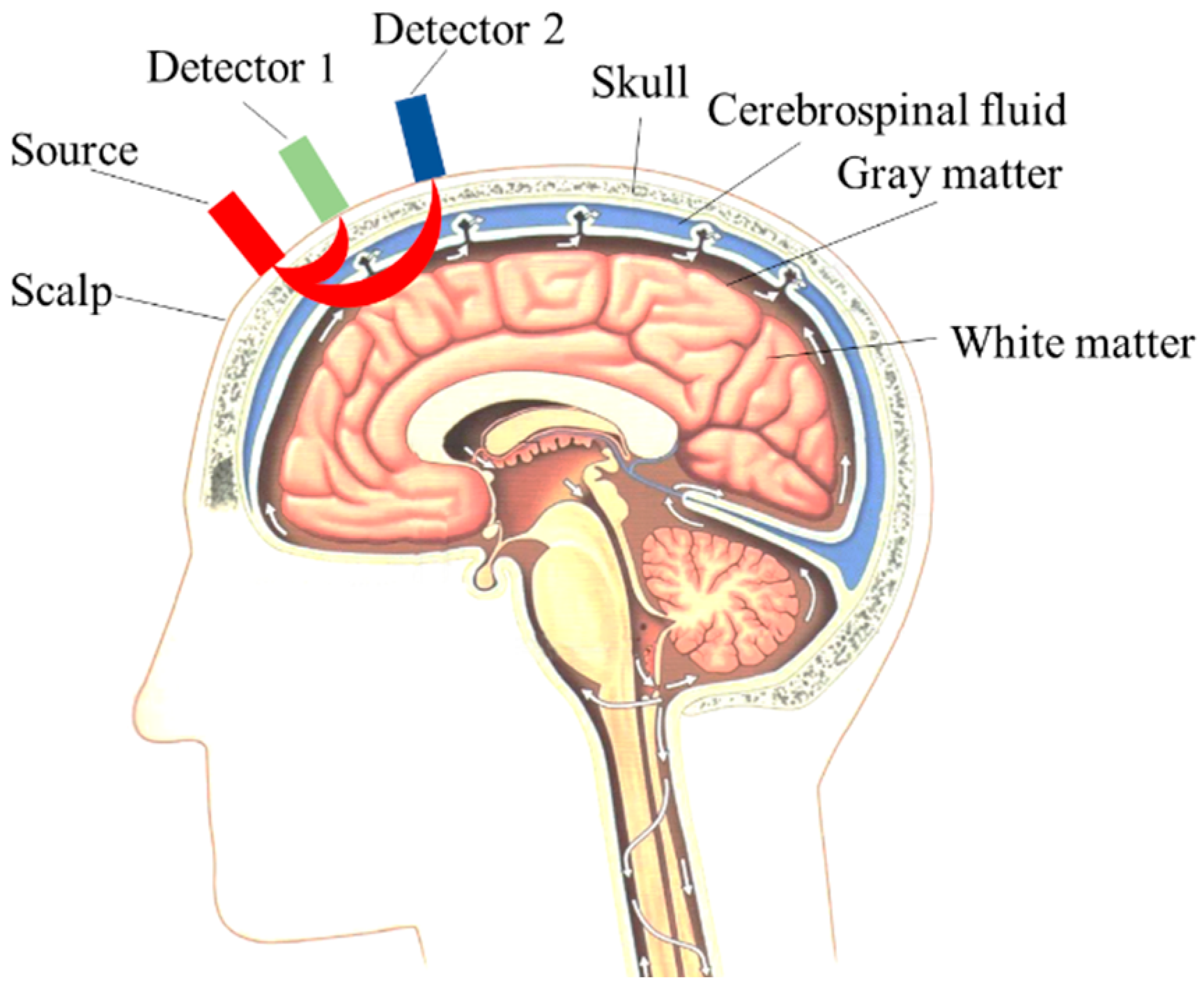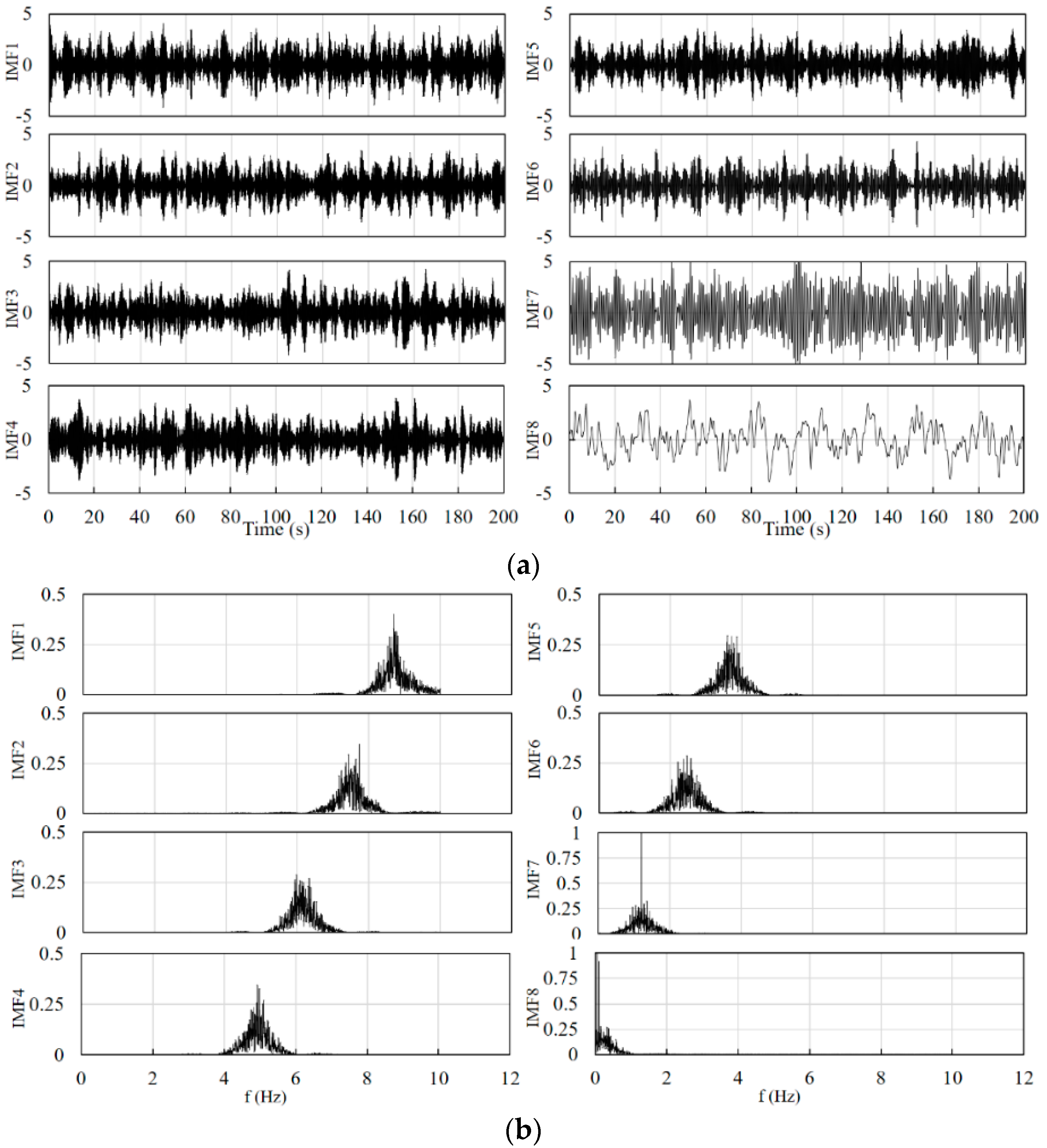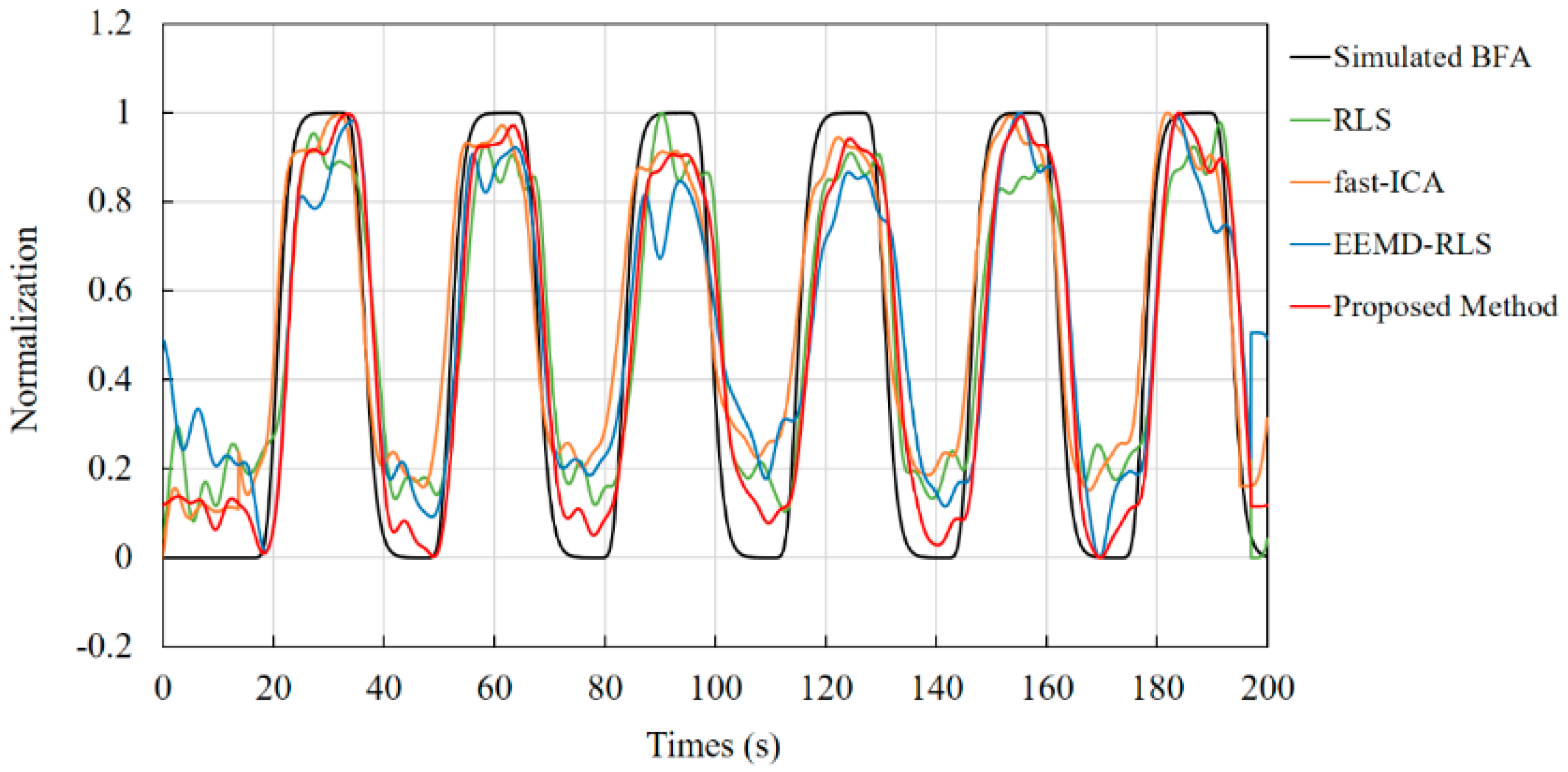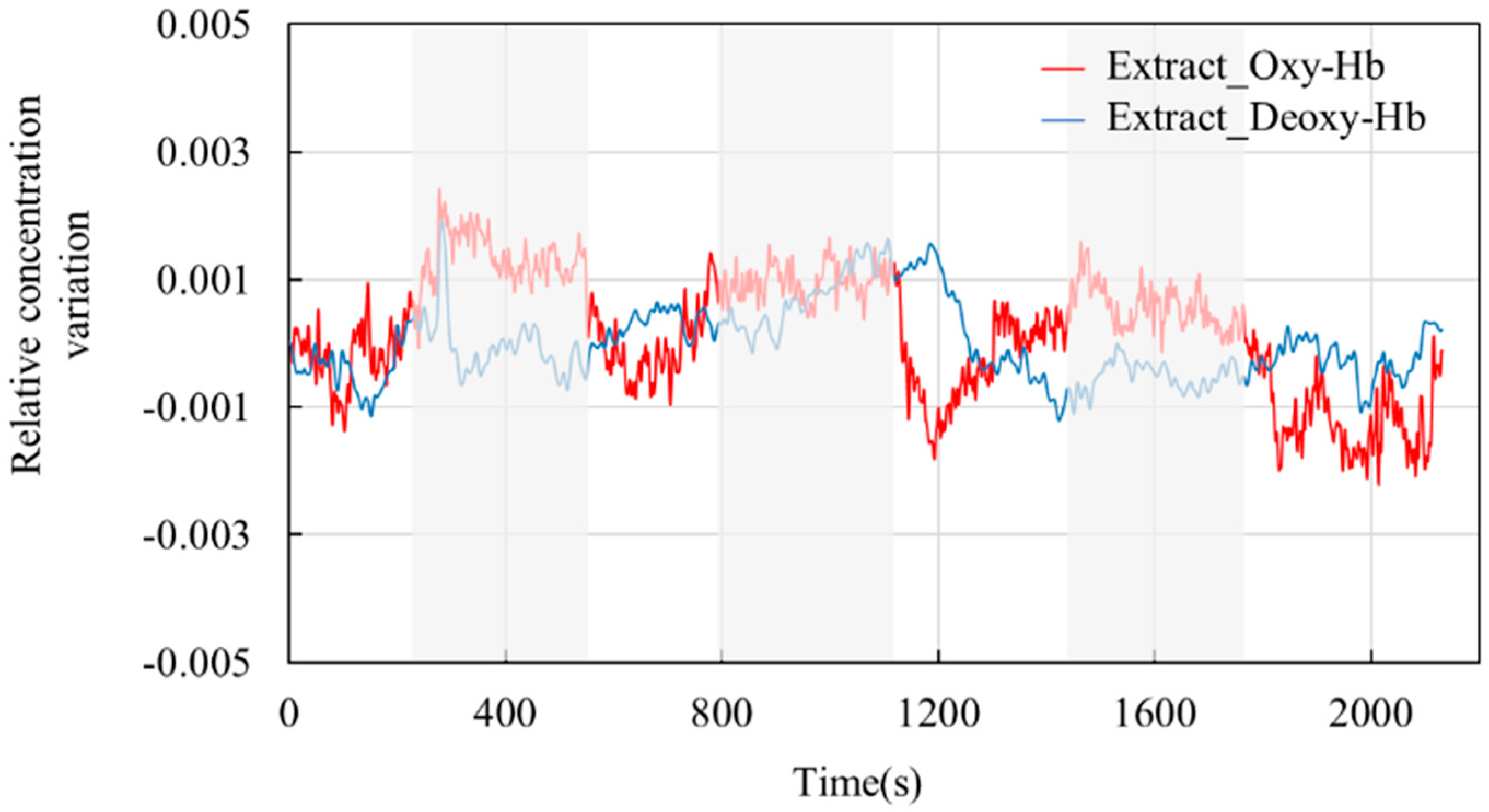Effective Signal Extraction Algorithm for Cerebral Blood Oxygen Based on Dual Detectors
Abstract
:1. Introduction
2. Theory and Methods
2.1. Variational Mode Decomposition
2.2. GA-VMD
2.3. Principle of Dual-Channel Extraction of Effective Physiological Information
3. Experimental Results and Analysis
3.1. Using Simulated Signals to Validate the Proposed Method
3.1.1. Generating the Hemodynamic Response and Physiological Interference
3.1.2. Compared Methods and Evaluation Index
3.1.3. Simulation Results and Evaluation Analysis
3.2. Using Measured Signals to Validate the Proposed Method
3.2.1. Compared Methods and Evaluation Index
3.2.2. Experimental Results and Analysis
4. Discussion
5. Conclusions
Supplementary Materials
Author Contributions
Funding
Institutional Review Board Statement
Informed Consent Statement
Data Availability Statement
Acknowledgments
Conflicts of Interest
Appendix A. The Derivation Process of the Proposed Method
References
- Li, Y.; Zhang, L.; Long, K.; Gong, H.; Lei, H. Real-time monitoring prefrontal activities during online video game playing by functional near-infrared spectroscopy. J. Biophotonics 2018, 11, e201700308. [Google Scholar] [CrossRef]
- Grossmann, T.; Johnson, M.H.; Tobias, G. Selective prefrontal cortex responses to joint attention in early infancy. Biol. Lett. 2010, 6, 540–543. [Google Scholar] [CrossRef] [PubMed]
- Huang, H.; Yuan, E.; Zhang, D.; Sun, D.; Yang, M.; Zheng, Z.; Zhang, Z.; Gao, L.; Panezai, S.; Qiu, K. Free Field of View Infrared Digital Holography for Mineral Crystallization. Cryst. Growth Des. 2023, 23, 7992–8008. [Google Scholar] [CrossRef]
- Bacigaluppi, S.; Zona, G.; Secci, F.; Spena, G.; Mavilio, N.; Brusa, G.; Agid, R.; Krings, T.; Ottonello, G.; Fontanella, M. Diagnosis of cerebral vasospasm and risk of delayed cerebral ischemia related to aneurysmal subarachnoid haemorrhage: An overview of available tools. Neurosurg. Rev. 2015, 38, 603–618. [Google Scholar] [CrossRef] [PubMed]
- Naseer, N.; Hong, K.-S. FNIRS-based brain-computer interfaces: A review. Front. Hum. Neurosci. 2015, 9, 1–15. [Google Scholar] [CrossRef] [PubMed]
- Irani, F.; Platek, S.M.; Bunce, S.; Ruocco, A.C.; Chute, D. Functional Near Infrared Spectroscopy (fNIRS): An Emerging Neuroimaging Technology with Important Applications for the Study of Brain Disorders. Clin. Neuropsychol. 2007, 21, 9–37. [Google Scholar] [CrossRef] [PubMed]
- Hong, K.-S.; Naseer, N.; Kim, Y.-H. Classification of prefrontal and motor cortex signals for three-class fNIRS–BCI. Neurosci. Lett. 2015, 587, 87–92. [Google Scholar] [CrossRef] [PubMed]
- Ge, S.; Yang, Q.; Wang, R.; Lin, P.; Gao, J.; Leng, Y.; Yang, Y.; Wang, H. A Brain-Computer Interface Based on a Few-Channel EEG-fNIRS Bimodal System. IEEE Access 2017, 5, 208–218. [Google Scholar] [CrossRef]
- Villringer, A.; Planck, J.; Hock, C.; Schleinkofer, L.; Dirnagl, U. Near infrared spectroscopy (NIRS): A new tool to study hemodynamic changes during activation of brain function in human adults. Neurosci. Lett. 1993, 154, 101–104. [Google Scholar] [CrossRef]
- Uchitel, J.; Vidal-Rosas, E.E.; Cooper, R.J.; Zhao, H. Wearable, Integrated EEG-fNIRS Technologies: A Review. Sensors 2021, 21, 6106. [Google Scholar] [CrossRef]
- Paulmurugan, K.; Vijayaragavan, V.; Ghosh, S.; Padmanabhan, P.; Gulyás, B. Brain–Computer Interfacing Using Functional Near-Infrared Spectroscopy (fNIRS). Biosensors 2021, 11, 389. [Google Scholar] [CrossRef] [PubMed]
- Zhang, X.; Noah, J.A.; Dravida, S.; Hirsch, J. Signal processing of functional NIRS data acquired during overt speaking. Neurophotonics 2017, 4, 041409. [Google Scholar] [CrossRef]
- Gagnon, L.; Yücel, M.A.; Boas, D.A.; Cooper, R.J. Further improvement in reducing superficial contamination in NIRS using double short separation measurements. NeuroImage 2014, 85, 127–135. [Google Scholar] [CrossRef] [PubMed]
- Zhang, Q.; Brown, E.N.; Strangman, G.E. Adaptive filtering for global interference cancellation and real-time recovery of evoked brain activity: A Monte Carlo simulation study. J. Biomed. Opt. 2007, 12, 044014. [Google Scholar] [CrossRef]
- Zhang, Y.; Liu, D.; Wang, Q.; Liu, X.; Yang, C.; Sun, J.; Lu, J.; Rolfe, P. EEMD and bidimensional RLS to suppress physiological interference for heterogeneous distribution in fNIRS study. J. Innov. Opt. Heal. Sci. 2018, 11, 1850039. [Google Scholar] [CrossRef]
- Tachtsidis, I.; Leung, T.S.; Tisdall, M.M.; Devendra, P.; Smith, M.; Delpy, D.T.; Elwell, C.E. Investigation of frontal cortex, motor cortex and systemic haemodynamic changes during anagram solving. Adv. Exp. Med. Biol. 2008, 614, 21–28. [Google Scholar]
- Tachtsidis, I.; Scholkmann, F. False positives and false negatives in functional near-infrared spectroscopy: Issues, challenges, and the way forward. Neurophotonics 2016, 3, 031405. [Google Scholar] [CrossRef] [PubMed]
- Behnam Molavi, G.; Dumont, A. Wavelet based motion artifact removal for Functional Near Infrared Spectroscopy. In Proceedings of the 2010 Annual International Conference of the IEEE Engineering in Medicine and Biology, Buenos Aires, Argentina, 31 August–4 September 2010; pp. 5–8. [Google Scholar]
- Santosa, H.; Hong, M.J.; Kim, S.-P.; Hong, K.-S. Noise reduction in functional near-infrared spectroscopy signals by independent component analysis. Rev. Sci. Instrum. 2013, 84, 073106. [Google Scholar] [CrossRef]
- Akgül, C.B.; Sankur, B.; Akın, A. Extraction of cognitive activity related waveforms from functional near infrared signals. In Proceedings of the 2006 14th European Signal Processing Conference, Florence, Italy, 4–8 September 2006; pp. 1–5. [Google Scholar]
- Zhang, Q.; Strangman, G.E.; Ganis, G. Adaptive filtering to reduce global interference in non-invasive NIRS measures of brain activation: How well and when does it work? Neuroimage 2009, 45, 788–794. [Google Scholar] [CrossRef]
- von Lühmann, A.; Li, X.; Müller, K.-R.; Boas, D.A.; Yücel, M.A. Improved physiological noise regression in fNIRS: A multimodal extension of the General Linear Model using temporally embedded Canonical Correlation Analysis. NeuroImage 2020, 208, 116472. [Google Scholar] [CrossRef]
- Saager, R.; Berger, A. Measurement of layer-like hemodynamic trends in scalp and cortex: Implications for physiological baseline suppression in functional near-infrared spectroscopy. J. Biomed. Opt. 2008, 13, 03417. [Google Scholar] [CrossRef] [PubMed]
- Prince, S.; Kolehmainen, V.; Kaipio, J.P.; Franceschini, M.A.; Boas, D.; Arridge, S.R. Time-series estimation of biological factors in optical diffusion tomography. Phys. Med. Biol. 2003, 48, 1491–1504. [Google Scholar] [CrossRef] [PubMed]
- Strangman, G.E.; Zhang, Q.; Li, Z. Scalp and skull influence on near infrared photon propagation in the Colin27 brain template. NeuroImage 2014, 85, 136–149. [Google Scholar] [CrossRef] [PubMed]
- Yoshitani, K.; Kawaguchi, M.; Miura, N.; Okuno, T.; Kanoda, T.; Ohnishi, Y.; Kuro, M. Effects of hemoglobin concentration, skull thickness, and the area of the cerebrospinal fluid layer on near infrared spectroscopy measurements. Anesthesiology 2007, 106, 458–462. [Google Scholar] [CrossRef]
- Hemmati Berivanlou, N.; Setarehdan, S.K.; Ahmadi Noubari, H. Evoked hemodynamic response estimation using ensemble empirical mode decomposition based adaptive algorithm applied to dual channel functional near infrared spectroscopy (fNIRS). J. Neurosci. Methods 2014, 224, 13–25. [Google Scholar] [CrossRef]
- Barnova, K.; Martinek, R.; Jaros, R.; Kahankova, R.; Matonia, A.; Jezewski, M.; Czabanski, R.; Horoba, K.; Jezewski, J. A novel algorithm based on ensemble empirical mode decomposition for non-invasive fetal ECG extraction. PLoS ONE 2021, 16, e0256154. [Google Scholar] [CrossRef]
- Azbari, P.G.; Abdolghaffar, M.; Mohaqeqi, S.; Pooyan, M.; Ahmadian, A.; Gashti, N.G. A novel approach to the extraction of fetal electrocardiogram based on empirical mode decomposition and correlation analysis. Australas. Phys. Eng. Sci. Med. 2017, 40, 565–574. [Google Scholar] [CrossRef]
- Funane, T.; Atsumori, H.; Katura, T.; Obata, A.N.; Sato, H.; Tanikawa, Y.; Okada, E.; Kiguchi, M. Quantitative evaluation of deep and shallow tissue layers’ contribution to fNIRS signal using multi-distance optodes and independent component analysis. NeuroImage 2014, 85, 150–165. [Google Scholar] [CrossRef]
- Zhang, Y.; Liu, X.; Yang, C.; Wang, K.; Sun, J.; Rolfe, P. A New Approach to Separate Haemodynamic Signals for Brain-Computer Interface Using Independent Component Analysis and Least Squares. Spectrosc. 2013, 2013, 950302. [Google Scholar] [CrossRef]
- Zhang, Y.; Sun, J.; Rolfe, P. Monte Carlo study for physiological interference reduction in near-infrared spectroscopy based on empirical mode decomposition. J. Mod. Opt. 2010, 57, 2159–2169. [Google Scholar] [CrossRef]
- Zhang, P.; Gao, D.; Lu, Y.; Kong, L.; Ma, Z. Online chatter detection in milling process based on fast iterative VMD and energy ratio difference. Measurement 2022, 194, 111060–111076. [Google Scholar] [CrossRef]
- Zhang, S.; Zhang, Y. Harmonic detection method based on permutation entropy and variational modal decomposition optimized by genetic algorithm. Rev. Sci. Instrum. 2021, 92, 025118. [Google Scholar] [CrossRef] [PubMed]
- Li, Y.; Tang, B.; Jiang, X.; Yi, Y. Bearing Fault Feature Extraction Method Based on GA-VMD and Center Frequency. Math. Probl. Eng. 2022, 2022, 2058258. [Google Scholar] [CrossRef]
- Zhang, Y.; Sun, J.; Rolfe, P. Reduction of global interference in functional multi-distance near-infrared spectroscopy using empirical mode decomposition and recursive least squares: A Monte Carlo study. J. Eur. Opt. Soc. 2011, 6, 11033. [Google Scholar] [CrossRef]
- Zhang, Y.; Sun, J.W.; Rolfe, P. RLS adaptive filtering for physiological interference reduction in NIRS brain activity measurement: A Monte Carlo study. Physiol. Meas. 2012, 33, 925–942. [Google Scholar] [CrossRef]
- Cho, T.H.; Nah, Y.; Park, S.H.; Han, S. Prefrontal cortical activation in Internet Gaming Disorder Scale high scorers during actual real-time internet gaming: A preliminary study using fNIRS. J. Behav. Addict. 2022, 11, 492–505. [Google Scholar] [CrossRef]
- Cui, X.; Bray, S.; Reiss, A.L. Functional near infrared spectroscopy (NIRS) signal improvement based on negative correlation between oxygenated and deoxygenated hemoglobin dynamics. NeuroImage 2010, 49, 3039–3046. [Google Scholar] [CrossRef]












| Tissue | Cardiac Cycle | Breath | Low-Frequency Oscillation | Ultra-Low-Frequency Oscillation | Evoked Response |
|---|---|---|---|---|---|
| Scalp | 0.2 | 0.6 | 0.9 | 1.0 | 0 |
| Skull | 0.2 | 0.63 | 0.96 | 1.1 | 0 |
| Cerebrospinal fluid | 0.02 | 0.06 | 0.08 | 0.1 | 0 |
| Gray matter | 0.2 | 0.65 | 0.92 | 1.1 | 15 |
| White matter | 0.2 | 0.6 | 0.9 | 1.0 | 0 |
| SNR | Method | Parameter | ||
|---|---|---|---|---|
| R | rMSE | MAE | ||
| SNR = 1 | Proposed method | 0.98482 | 0.09646 | 0.08337 |
| RLS | 0.92799 | 0.18884 | 0.16952 | |
| fast-ICA | 0.98299 | 0.15231 | 0.12925 | |
| EEMD-RLS | 0.89344 | 0.22046 | 0.19163 | |
| SNR = 2 | Proposed method | 0.98567 | 0.09343 | 0.07951 |
| RLS | 0.91562 | 0.18987 | 0.15979 | |
| fast-ICA | 0.98508 | 0.14484 | 0.12397 | |
| EEMD-RLS | 0.96321 | 0.14814 | 0.12528 | |
| SNR = 4 | Proposed method | 0.98764 | 0.08761 | 0.07661 |
| RLS fast-ICA EEMD-RLS | 0.98166 0.97678 0.95345 | 0.11452 0.17078 0.16344 | 0.10194 0.14357 0.13802 | |
Disclaimer/Publisher’s Note: The statements, opinions and data contained in all publications are solely those of the individual author(s) and contributor(s) and not of MDPI and/or the editor(s). MDPI and/or the editor(s) disclaim responsibility for any injury to people or property resulting from any ideas, methods, instructions or products referred to in the content. |
© 2024 by the authors. Licensee MDPI, Basel, Switzerland. This article is an open access article distributed under the terms and conditions of the Creative Commons Attribution (CC BY) license (https://creativecommons.org/licenses/by/4.0/).
Share and Cite
Xing, Z.; Jin, Z.; Fang, S.; Gao, X. Effective Signal Extraction Algorithm for Cerebral Blood Oxygen Based on Dual Detectors. Sensors 2024, 24, 1820. https://doi.org/10.3390/s24061820
Xing Z, Jin Z, Fang S, Gao X. Effective Signal Extraction Algorithm for Cerebral Blood Oxygen Based on Dual Detectors. Sensors. 2024; 24(6):1820. https://doi.org/10.3390/s24061820
Chicago/Turabian StyleXing, Zhiming, Zihao Jin, Shuqi Fang, and Xiumin Gao. 2024. "Effective Signal Extraction Algorithm for Cerebral Blood Oxygen Based on Dual Detectors" Sensors 24, no. 6: 1820. https://doi.org/10.3390/s24061820
APA StyleXing, Z., Jin, Z., Fang, S., & Gao, X. (2024). Effective Signal Extraction Algorithm for Cerebral Blood Oxygen Based on Dual Detectors. Sensors, 24(6), 1820. https://doi.org/10.3390/s24061820





